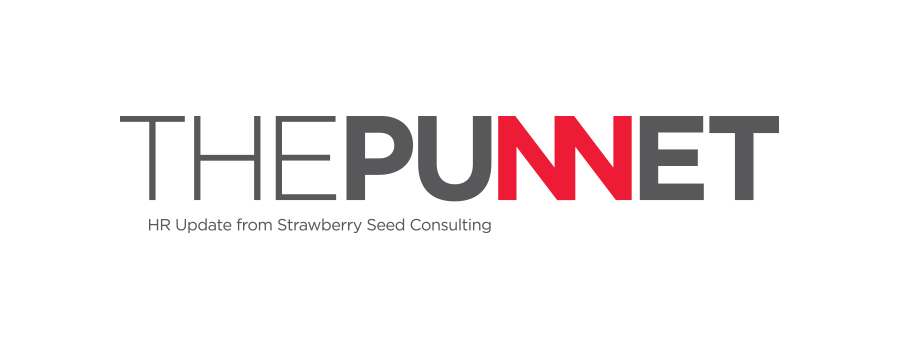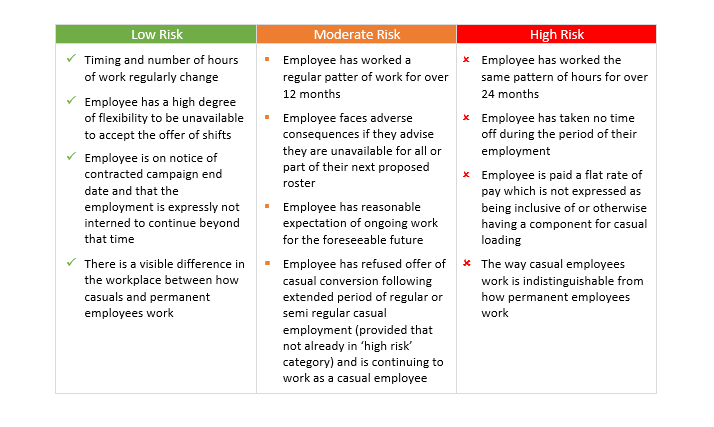
What is happening in the world of HR for small business?
Minimum Wage Increase
2020 has thrown up many challenges, and the Fair Work Commission review of the national minimum wage is no exception. This year, the Panel tasked with the review was confronted with challenging macroeconomic circumstances arising from the COVID-19 pandemic, including an anticipated fall in Australian GDP by up to 8% and a significant increase in unemployment. This led to an extension for submissions and a later than the usual decision.
On Friday, they announced that the Minimum Wage would increase by 1.75%. The new minimum wage will be $19.84 per hour or $753.80 per week. In the past, this increase would be effective from the first pay period after 1 July for all. The increase will be implemented in stages this year for employees covered by an award depending on your industrial outlined below.
Group 1 – effective from 1 July 2020
- Frontline Healthcare & Social Assistance Workers
- Teachers and Childcare
- Other essential services
Group 2 – effective from 1 November 2020
- Construction
- Manufacturing
- Clerical
- A range of other industries
Group 3 – effective 1 February 2021
- Accommodation and food services
- Arts and recreation services
- Retail
- Tourism
A full list of all awards and which group they fall into can be found here.
Since 1 July 2018, the minimum wage has increased by a total of 8.25%. So if you haven’t recently reviewed your employees’ salaries to ensure they are still meeting the minimum requirements, now is the time.
It is also a great time to check rates for employees that receive a flat hourly rate are still meeting the Better Off Overall Test (BOOT). Victoria is looking to be the first state to bring in Wage Theft Laws, and other states will follow. A case in NSW saw a company Director incur a personal fine of $39,000 for underpayment of wages. One of our HR Team, Frances Orr, shared her thoughts on what small business owners can learn from this case in her article ‘Are you at risk when paying employees a ‘flat rate’?’.
If you would like one of the Strawberry Seed Team to assist you with an audit of your employee wages, please give us a call on (03) 4216 5200 or book a meeting online.
FAQ’s on Managing in COVID-19
Managing your team through this pandemic has been an everchanging situation. It is no wonder there is still confusion around employer obligations and employee entitlements. We thought we would address some of the most common questions we are currently getting from our HR clients.
How does leave work if my employees are receiving JobKeeper?
This is a question we are getting almost once a week. Fortunately, the answer to this one is simple. The rules around taking leave have not changed. Employees can still access their annual leave and personal leave entitlements as usual.
Annual Leave
Annual leave must be approved by the employer and granted in line with company policy and business needs. Employers can still say no on reasonable grounds (for example, it would leave them short-staffed as other employees are already on leave).
From a pay perspective, the employee’s pay should be processed in the same way it was before, and then JobKeeper applied as a top-up payment if they earn below the $1500 per fortnight.
There are also now provisions available to employers to direct employees to take annual leave under the JobKeeper flexibilities in the Fair Work Act. Also, there have been adjustments to many awards to allow for this as well. If you are planning on directing employees to take annual leave, we recommend seeking advice as there are requirements you must meet.
Personal Leave
The rules around Personal Leave have also not changed. You can request evidence if an employee is absent from work due to illness or to care for a family member.
From a pay perspective, the employee’s pay should be processed in the same way it was before, and then JobKeeper applied as a top-up payment if they earn below the $1500 per fortnight.
We have seen some cases where employees who have run out of Personal Leave are taking unpaid sick leave knowing that they will still be paid the JobKeeper top-up. These situations must be handled carefully to avoid unintended legal ramifications and potential general protection claims. If the employee is providing evidence for their absence, they are entitled to take the leave. Please get in touch with our team if you need assistance to manage in these circumstances.
When and how do we return everyone to work?
I wish I could give you a magic step by step plan on getting everyone back to work as they were before the pandemic. The reality is that every business is unique. Some industries are still entirely shut down. Some never stopped trading as usual. Most companies fall somewhere in between. There are still different rules in different states.
A starting point for each business needs to gather the information that is relevant to their state health regulations and industry-specific guidelines. A medical clinic will have different things to consider when compared to an office or factory environment.
As you assess the options and make your plan, some things to consider when you are transitioning employees back to a physical workspace will include:
- Will you implement workforce screening?
- What hygiene practices do you have in place?
- Can you meet social distancing requirements?
- What are the challenges for physical work layouts?
- What is your plan for a positive case in your workplace?
- What are the mental health repercussions for employees?
- How do your employees travel to and from work?
- Operationally, what roles can be continued to be performed at home?
- What do your team want to do v what you operationally need to do?
These questions are the tip of the iceberg. It is important to remember that it does not have to be all or nothing. A planned and staged return may be the best option for your business rather than all back at once. Some roles may be able to be performed at home indefinitely. Maybe a combination of working from home and the office can work.
There is only one thing we recommend to ensure success. Communication. Communicate with your staff often, even if you have nothing new to add. Misinformation and rumour grow in a vacuum of silence and lead to speculation.
Get your employees involved in the planning. Consult with them, so you understand their concerns. Get their input. They will have great ideas that you may not have considered. Employee consultation will increase employee buy-in and can make the transition easier for everyone.
The reality is, many businesses will be working in the ‘new normal’ for quite some time. This will mean remote working will be part of how we manage. Our HR Advisor, Natalie Raidme, shared her tips on onboarding employees who are working from home in a recent article.
Can I still make an employee redundant?
The laws around redundancy remain unchanged. An employee can be made redundant if the position they hold is no longer required to be performed in the business.
There are requirements under the Fair Work Act and applicable industrial instruments that set out the steps that you need to take if you are considering making one or more positions redundant. This includes the consultation process, redeployment consideration and employee entitlements.
Redundancy should not be taken lightly and must not be seen as an easy way to get rid of an employee with performance or conduct issues. The Fair Work Commission will be carefully scrutinising redundancies, and we have already worked with a client that had an employee take an unfair dismissal case against them after being made redundant in April.
Every circumstance is different, and we expect to see an increased need for employers to look at the option of reducing their workforce over the coming months. We can provide advice on redundancies to ensure you minimise the risk to your business. Give us a call on (03) 4216 5200 or book a meeting online.
Casual Employees
Casual employment has hit the headlines again recently with the result of the latest appeal in the original case of WorkPac Pty Ltd v Skene (2018). The issue was whether Mr Skene was actually a permanent employee and therefore entitled to annual leave.
The latest decision from WorkPac Pty Ltd v Rossato (2020), which will again be appealed, has essentially ruled that an employee that is receiving a casual loading can also be accruing leave entitlement if they are found to be a permanent employee. It also found that the casual loading already paid cannot be used to offset the leave entitlements. We will watch this space as this continues through the courts.
At Strawberry Seed, we know that this is an area that causes a lot of confusion. But what this case highlights are the fact that as an employer, you must get the classification for your employees correct. Here are a few things to consider when it comes to casual employment.
Definition of a casual
There is no such thing as a permanent casual although that term is thrown around all the time. By definition, the casual employee is engaged on a per shift basis and should not expect regular and systematic work.
A casual employee:
- has no guaranteed hours of work
- usually works irregular hours
- does not expect ongoing employment
- does not receive paid sick or annual leave
- can end employment without notice (unless notice is required by a registered agreement, Award or employment contract)
- is not defined in the Fair Work Act
What are the risks?
There are varying levels of risk when it comes to employing a casual. This table (as provided by K & L Gates in a recent webinar) summarises the risks. As you can see, many variables need to be considered to minimise the risk to your business.
There are several differences in entitlements between a permanent (full-time or part-time) and a casual employee. These include access to leave and termination. If a casual employee can prove they are employed on a regular, predictable and systematic basis for a prolonged period, it can change their entitlements under employment law. It can also open up their access to unfair dismissal.
Actions to take if you employ casuals
Before engaging an employee as a casual, think about what the business needs:
- Are you filling an ongoing vacancy left by a permanent employee?
- Do you need someone to work on mainly days when you are busy?
- Do you need someone only to cover periods of leave?
- Is the nature of the work unpredictable, and you need flexibility in the way you employ?
Don’t set and forget:
- Monitor the employment relationship on an ongoing basis
- What is the actual nature of the work? Has it changed?
- Make sure the casual employment does not morph into permanency
Casual Conversion Clause
A casual conversion clause exists in almost all awards. Employers should review the Modern Award/s that apply to their employees and ensure they are familiar with this clause. If this clause is included in your applicable awards, the following actions are required:
- For casuals that have been employed in your business before the 1 October 2018, you should have already provided a copy of the relevant casual conversion clause.
- For casuals employed after 1 October 2018, employers must provide a new casual with a copy of the casual conversion clause within the first 6 or 12 months of their engagement (depending on the award).
We also recommend that employers consider including the relevant Casual Conversion clause in the Casual Employment Agreement to ensure that they do not miss this step down the track.
Need advice when it comes to employing casuals? Give us a call on (03) 4216 5200 or book a meeting online.
Are you ready for the 2020/21 Financial year?
With so many competing challenges being thrown at small business right now, it is not surprising that we get to the end of the financial year and find that some HR issues have been sent to the bottom of the list. In our article, 5 EOFY HR Questions for Small Business, we provide some tips around crucial matters such as the Minimum Wage Increase, that are well worth focussing on to avoid problems down the track.




